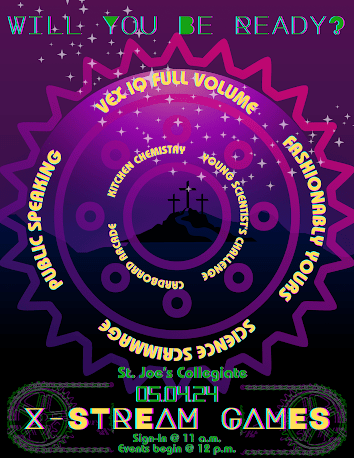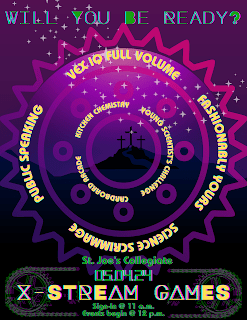Turn Around, Bright Eyes
THWARTED BY 7-YEAR OLDS
Readied with plans to talk about things like Light,
Prisms, Rainbows and Noah's Ark with my second-grade STREAM class at St.
Peter's school in Lewiston this past week, before I knew it, the proverbial
monkeys had taken over the zoo. Indeed, I was bombarded with questions about
the upcoming solar eclipse, a topic which was NOT in my lesson
plans but was one in which I was delighted to explore along with them. (This may be my favorite part about teaching
STREAM: when unrelenting curiosity arises, more often than not I am able to
indulge my students' eagerness to learn!)
You've probably heard, there's going to be a solar eclipse on April 8 this year, and Western New York is right along the path of totality. According to a report on WKBW-TV, this is serious business, with Erie County Executive Mark Poloncarz even considering a county-wide shut-down, just as though we might expect for a snowstorm. “The traffic is going to be horrible," Poloncarz warns according to the report, adding, “Your best place to watch the eclipse is probably at your home, as long as you have a clear view of the sun it doesn't matter where you are."
This astrological event may very well create a tremendous opportunity for Catholic school educators to capitalize on STREAM Project-Based Learning. Though due to Easter, our students will not be in school that Monday, there are many resources we can tap - locally and beyond - which can bring STREAM PBL into your schools and classrooms.
NEXT LEVEL LEARNING
What if the educational teams in your school could do
one better than just have a science unit that addresses the Solar Eclipse? What
if there was an integrated and immersive experience wherein the students get a
full and well-rounded STREAM education that meets standards and promotes
student engagement? And now, hear me
out… what if EVERYONE in the building had Total Eclipse Fever?
For example:
Science and Math combine with learning experiences that include Next Generation "Earth's Place in the Universe" (ESS) and Math topics such as time, representing & interpreting data, ratios & proportions, modeling, and geometry.
BUT WAIT, THERE'S MORE…
We can also throw Religion into this mix! I'll get you started with a few articles and sites that reference where the Bible talks about Eclipses, religious and cultural significance of eclipse events, and how science has used the Bible determine datelines of early references to their existence. (Added bonus: Community, Career & Civic (C3) Social Studies standards can also fit in here):
- The Universe Remains. Pope Francis' Astronomer in Finding Meaning in the Eclipse
- Bible Verses about Eclipse
- How Lunar and Solar Eclipses Shed Light on Biblical Events
- How Scientists Identified the Oldest Known Solar Eclipse… Using the Bible
DON'T LET SCIENCE AND MATH ECLIPSE ART
Curriculum Extension teachers can catch Eclipse Fever
as well. For example, art teachers could refer to Alma Thomas' work "The Eclipse" to inspire projects
for students at any level. Music can
also join the art party, exploring songs that reference these celestial events
(Pink Floyd, anyone?) or even better, show your students this NatGeo article about how scientists are now able
to include the visually impaired in experiencing an eclipse by creating a way
hear it. And, I don't know who needs to read this today, but let this be a
loving reminder that writing and performing are also valid art forms.
To tie this all together in to a PBL experience, Technology and Engineering become a natural fit (although it could be argued that those elements are already organically present.) For example, students could be assigned a project where they must create their own representation of the eclipse. It could be done as any kind of project they choose (creating a 3-d replica, a musical or artwork piece, poetry or a story, an experiment), but it must include a journal that illustrates how they've applied the Engineering Process (Ask, Imagine, Plan, Create, Test, Improve). Technology would be a natural element to this if students are able to use personal learning devices such as Chromebooks for research, but could also include robotics, video documenting, graphic design, and more.
The beauty of using this "All Hands on Deck" collaborative PBL model, is that it allows great opportunities for students to deep-dive into a topic in a way that allows instruction to meet multiple learning standards (thereby saving time!), makes room to be adaptable for differentiated learning strategies, and creates memorable, immersive learning from many angles - all while encouraging students to chart their own path in their learning. Educators need only make a few adjustments to make this a successful and beneficial learning experience.
---
MORE RESOURCES
Buffalo-Area
https://www.buffaloastronomy.com/solar-eclipse-2024/
https://www.sciencebuff.org/eclipse/
https://www.clclockport.org/2024-eclipse.html
https://planetarium.buffalostate.edu/
https://www.williamsvillek12.org/departments/teaching_and_learning/science/planetarium/index.php
https://penndixie.org/?s=eclipse
Additional Resources:
My
Nasa Data
https://mynasadata.larc.nasa.gov/mini-lessonactivity/what-solar-eclipse
National
Solar Observatory
https://nso.edu/for-public/educators-old-page/eclipse-lessons/
Brain
Pop Lessons
https://educators.brainpop.com/lesson-plan/eclipse-lesson-plan-earths-place-in-the-universe/
NASA
Jet Propulsion Lab
https://www.jpl.nasa.gov/edu/teach/tag/search/eclipse
Elementary
School Science
https://www.elementaryschoolscience.com/solar-lunar-eclipses-lesson-plans
Kids
Eclipse
https://kidseclipse.com/lesson-plan-outline/
Lunar and Solar Eclipse Explained: A Beginner’s Guide to Eclipses
Solar eclipse foldable craft tutorial for school project and science lessons
How to Draw the Solar Eclipse Chalk Art Project for Kids
Creating Alma Thomas "The Eclipse" Inspired Art with Mrs. Engeling
Epic Eclipse: A 'Pi in the Sky' Math Challenge
Khan Academy - Conic Sections & Ellipses
Illustrative Mathematics - Solar Eclipse Task
University of Southern Indiana - Eclipse Math
My NASA Data - Modeling Solar Eclipse Geometry


Comments
Post a Comment